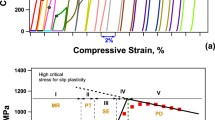Abstract
A method is described for the creation of surfaces with cyclically reversible topographical form. Using spherical and cylindrical indenters applied to NiTi shapememory alloys, an indentation-planarization technique is shown to result in a two-way shape memory effect that can drive flat-to-wavy surface transitions on changing temperature. First, it is shown that deep spherical indents, made in martensitic NiTi, exhibit pronounced two-way cyclic depth changes. After planarization, these two-way cyclic depth changes are converted to reversible surface protrusions, or “exdents.” Both indent depth changes and cyclic exdent amplitudes can be related to the existence of a subsurface deformation zone in which indentation has resulted in plastic strains beyond that which can be accomplished by martensite detwinning reactions. Cylindrical indentation leads to two-way displacements that are about twice as large as that for the spherical case. This is shown to be due to the larger deformation zone under cylindrical indents, as measured by incremental grinding experiments.
Similar content being viewed by others
References
W.Y. Ni, Y.T. Cheng, and D.S. Grummon: Recovery of microindents in a nickel-titanium shape-memory alloy: A “selfhealing” effect. Appl. Phys. Lett. 80, 3310 (2002).
W.Y. Ni, Y.T. Cheng, and D.S. Grummon: Microscopic superelastic behavior of a nickel-titanium alloy under complex loading conditions. Appl. Phys. Lett. 82, 2811 (2003).
R. Liu, D.Y. Li, Y.S. Xie, R. Llewellyn, and H.M. Hawthorne: Indentation behavior of pseudoelastic TiNi alloy. Scr. Mater. 41, 691 (1999).
F.T. Cheng, P. Shi, and H.C. Man: Correlation of cavitation erosion resistance with indentation-derived properties for a NiTi alloy. Scr. Mater. 45, 1083 (2001).
K. Gall, K. Juntunen, H.J. Maier, H. Sehitoglu, and Y.I. Chumlyakov: Instrumented micro-indentation of NiTi shape-memory alloys. Acta Mater. 49, 3205 (2001).
G.A. Shaw, D.S. Stone, A.D. Johnson, A.B. Ellis, and W.C. Crone: Shape memory effect in nanoindentation of nickel-titanium thin films. Appl. Phys. Lett. 83, 257 (2003).
X.G. Ma and K. Komvopoulos: Nanoscale pseudoelastic behavior of indented titanium-nickel films. Appl. Phys. Lett. 83, 3773 (2003).
X.G. Ma and K. Komvopoulos: Pseudoelasticity of shape-memory titanium-nickel films subjected to dynamic nanoindentation. Appl. Phys. Lett. 84, 4274 (2004).
L.M. Qian, X.D. Xiao, Q.P. Sun, and T.X. Yu: Anomalous relationship between hardness and wear properties of a superelastic nickel-titanium alloy. Appl. Phys. Lett. 84, 1076 (2004).
C. Liu, Y.P. Zhao, Q.P. Sun, T.X. Yu, and Z.X. Cao: Characteristic of microscopic shape memory effect in a CuAlNi alloy by nanoindentation. J. Math. Sci. 40, 1501 (2005).
C. Liu, Y.P. Zhao, and T.X. Yu: Measurement of microscopic deformation in a CuAlNi single crystal alloy by nanoindentation with a heating stage. Mater. Des. 26, 465 (2005).
G.A. Shaw, J.S. Trethewey, A.D. Johnson, W.J. Drugan, and W.-C. Crone: Thermomechanical high-density data storage in a metallic material via the shape-memory effect. Adv. Math. 17, 1123 (2005).
P. Frick, A.M. Ortega, J. Tyber, A.E.M. Maksound, H.J. Maier, Y.N. Liu, and K. Gall: Thermal processing of polycrystalline NiTi shape memory alloys. Mater. Sci. Eng., A 405, 34 (2005).
W.M. Huang, J.F. Su, M.H. Hong, and B. Yang: Pile-up and sink-in in micro-indentation of a NiTi shape-memory alloy. Scr. Mater. 53, 1055 (2005).
G. Ma: Pseudoelasticity of martensitic titanium-nickel shape-memory films studied by in situ heating nanoindentation and transmission electron microscopy. Appl. Phys. Lett. 87, 263108 (2005).
C.P. Frick, T.W. Lang, K. Spark, and K. Gall: Stress-induced martensitic transformations and shape memory at nanometer scales. Acta Mater. 54, 2223 (2006).
H.S. Zhang and K. Komvopoulos: Nanoscale pseudoelasticity of single-crystal Cu–Al–Ni shape-memory alloy induced by cyclic nanoindentation. J. Math. Sci. 41, 5021 (2006).
A.J. Muir Wood and T.W. Clyne: Measurement and modelling of the nanoindentation response of shape memory alloys. Acta Mater. 54, 5607 (2006).
J.F. Su, W.M. Huang, and H.M. Hong: Indentation and two-way shape memory in a NiTi polycrystalline shape-memory alloy. Smart Mater. Struct. 16, S137 (2007).
W.C. Crone, H. Brock, and A. Creuziger: Nanoindentation and microindentation of CuAlNi shape memory alloy. Exp. Mech. 47, 133 (2007).
W.Y. Yan, Q.P. Sun, X.Q. Feng, and L.M. Qian: Analysis of spherical indentation of superelastic shape memory alloys. Int. J. Solids Struct. 44, 1 (2007).
M. Arciniegas, J.M. Manero, J. Pena, F.J. Gil, and J.A. Planell: Study of new multifunctional shape memory and low elastic modulus Ni-free Ti alloys. Metall. Mater. Trans. A 39, 742 (2008).
Y.J. Zhang, Y.T. Cheng, and D.S. Grummon: Two-way indent depth recovery in a NiTi shape memory alloy. Appl. Phys. Lett. 88, 1904 (2006).
Y.J. Zhang, Y.T. Cheng, and D.S. Grummon: Shape memory surfaces. Appl. Phys. Lett. 89, 1912 (2006).
D. Tabor: Indentation hardness: Fifty years on a personal view. Philos. Mag. A 74, 1207 (1996).
D. Tabor: A simple theory of static and dynamic hardness. Proc. R. Soc. London Ser. A 192, 247 (1948).
J. Fernandez, X.M. Zhang, and J.M. Guilemany: A one-cycle training technique for copper-based shape memory alloys. J. Mater. Process. Technol. 139, 117 (2003).
R. Stalmans, J.V. Humbeeck, and L. Delaey: Thermomechanical cycling, 2-way memory and concomitant effects in Cu–Zn–Al alloys. Acta Metall. Mater. 40, 501 (1992).
Y. Liu and J.V. Humbeeck: Two-way shape memory effect developed by martensite deformation in NiTi. Acta Mater. 47, 199 (1998).
J.J. Wang: Two-way shape memory effect induced by cold-rolling in Ti-Ni and Ti-Ni-Fe alloys. Scr. Mater. 52, 311 (2005).
R. Lahoz, L. Gracia-Villa, and J.A. Puertolas: Training of the two-way shape memory effect by bending in NiTi alloys. J. Eng. Mater. Technol. 124, 397 (2002).
Y.J. Zhang, Y.T. Cheng, and D.S. Grummon: Understanding indentation-induced two-way shape memory effect. J. Mater. Res. 22, 2851 (2007).
Author information
Authors and Affiliations
Corresponding author
Additional information
This author was an editor of this focus issue during the review and decision stage. For the JMR policy on review and publication of manuscripts authored by editors, please refer to http://www.mrs.org/jmr_policy
Rights and permissions
About this article
Cite this article
Fei, X., Zhang, Y., Grummon, D.S. et al. Indentation-induced two-way shape memory surfaces. Journal of Materials Research 24, 823–830 (2009). https://doi.org/10.1557/jmr.2009.0101
Received:
Accepted:
Published:
Issue Date:
DOI: https://doi.org/10.1557/jmr.2009.0101




